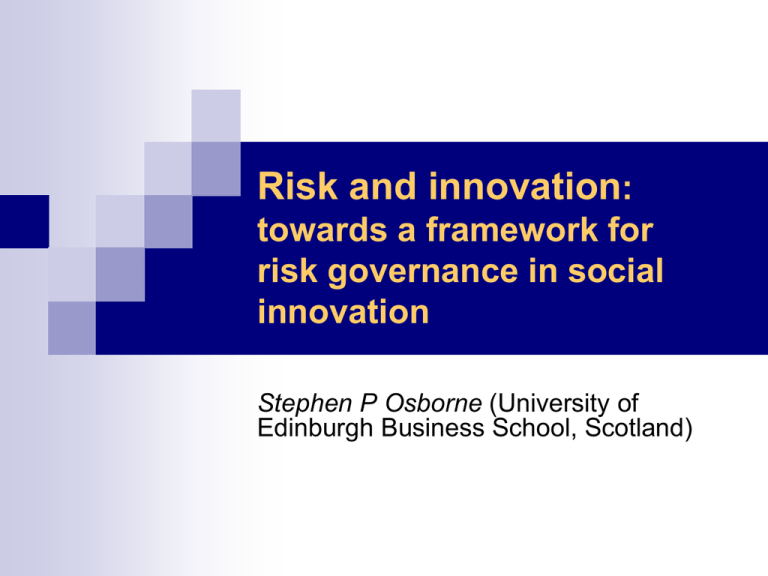Risk and social innovation
advertisement

Risk and innovation:
towards a framework for
risk governance in social
innovation
Stephen P Osborne (University of
Edinburgh Business School, Scotland)
Learning from innovation in
public sector environments
(LIPSE)
Outline of presentation
Risk
Risk and public services
Risk and social innovation
Locus of risk
Risk in public policy
A new starting point
Risk: three approaches
Risk and social innovation: the challenges
University of Edinburgh Business
School
Risk
Risk - ‘the probability that something might
happen’
Risk (known unknowns) and uncertainty
(unknown unknowns) a key differentiation
Risk is socially constructed: what is a risk and
how much are we prepared to bear, for what
outcomes?
University of Edinburgh Business
School
Risk and public services
Risk core element of public services (e.g. open heart
surgery, community care, new business support)
Research on risk in public services limited
Risk management as reducing public service
accountability (Harman 1994)
Risk as higher for public than private services and
concerned with risk minimisation (Vincent 1996)
Risk management as a ‘blame game’ (Hood 2002)
Risk as multi-faceted and complex phenomenon in
public services (Lodge 2009)
University of Edinburgh Business
School
Risk and social innovation
Social innovation is a key policy trajectory
in the UK, across Europe – and elsewhere
‘Social
innovation’ is poorly understood and
over-used
Innovation as a process of discontinuity
not gradual change and therefore…
Risk
is a key element of the social innovation
process but is also poorly understood in policy
and practice inUniversity
public
services
of Edinburgh Business
School
Four types of innovation
Incremental
(developing existing services and
skills)
Expansionary (meeting new needs using the
same skill base)
Evolutionary (meeting existing needs using
new skills)
Total (meeting new needs using new skills)
University of Edinburgh Business
School
Locus of risk in social
innovation
Consequential – direct risk to service
user
Organisational – risk to
professional/organisational reputation or
legitimacy
Behavioural – risk to stakeholders
surrounding the service and/or the wider
community
University of Edinburgh Business
School
Risk and social innovation public
policy: the example of the UK
Public policy acknowledges complexity of risk in innovation but
rarely moves beyond bland guidance in practice (Audit Commission
2007, Cabinet Office 2008)
NESTA/Young Foundations – need to ‘manage risk not eliminate it’
(2008)
Dominance of actuarial approaches to risk (NAO 2000, ALARM
2009)
AND CONSEQUENTLY scant guidance on the specific challenges
of risk governance in innovation, such as
Risk as a positive element of innovation process
Co-production
Negotiating across multiple/contested stakeholders
University of Edinburgh Business
School
Risk and social innovation and
risk: a new starting point
Understanding risk in social innovation
Requires
acceptance of its inevitability, the
need to govern it and make decisions about
acceptable levels of risk for social benefit
Requires an ‘open systems’ approach,
both because of the fragmented nature of public
services delivery and
because effective innovation requires a
collaborative and open orientation
University of Edinburgh Business
School
Risk governance – three
approaches I
I - Risk minimisation (actuarial) acknowledges risk and
seeks to minimise its presence and costs (closed systems
approach) {Stultz 1996}
II - Risk analysis (health & safety) acknowledges risk and
seeks to manage its consequences (natural systems
approach) {Rasmussen 1997}
Risk analysis
Risk assessment
Risk management
Both these approaches see risk as negative and avoidable –
but for innovation risk is necessary and must be negotiated
University of Edinburgh Business
School
Risk governance – three
approaches II
III – Negotiated risk governance (Renn 2008)
Technocratic (decision taking on technical grounds by
professionals) {risk minimisation}
Limited by scientific knowledge
Ignores social context and construction of risk
Decisionistic (combines above with political decision
making) {risk analysis}
Process of negotiation of risk for given outcomes
Transparent (combines above with stakeholder
engagement)
Involvement of end users of innovation/others
True ‘risk governance’
Resonance with ‘digital era governance’
University of Edinburgh Business
School
How to govern risk in innovation in public services in a
way that
Acknowledges it as an inevitable part of the
innovation process,
That is flexible to range of different levels of risk and
uncertainty in different public service innovations,
That engages the full, appropriate, range of
stakeholders for any innovation, and
Is sophisticated enough to enable the negotiation of
acceptable levels of risk for given outcomes.
University of Edinburgh Business
School
Risk and innovation – an
integrated framework
TYPE OF
INNOVATION
MODE OF RISK GOVERNANCE
Risk
Analysis
(decisionistic)
Risk Negotiation
(transparent governance)
Expansionary
X
X
Evolutionary
X
X
Incremental
Risk
Minimisation
(technocratic)
X
X
Total
University of Edinburgh Business
School
Risk governance in social
innovation in practice
Stage 1: Adopt an appropriate mode of risk
governance – not normative! (all)
Stage 2: Analyse the type of risk and where it falls (all)
Stage 3: Identify potential and perceived risk and
benefits/outcomes (all)
Stage 4: Collaborate with stakeholders to reach
shared understanding of acceptable risk (RG)
Stage 5: Build in accountability (RG)
University of Edinburgh Business
School
An implementation checklist
How is risk constructed in social innovation in your
service and understood by the different stakeholders?
What are the requisite governance structures?
How to positively engage professionals, politicians, citizens,
and/or users to an effective resolution
Regulatory, political and cross-organisational forms
Can governance models keep up with an information rich
society?
What skills will these individuals require for effective
resolution?
University of Edinburgh Business
School











